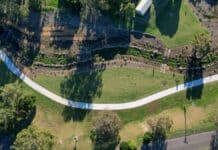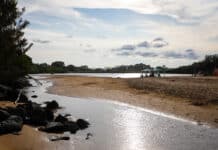

A network of sensors that measure light pollution will soon dot the Bundaberg Region coastline as part of a cooperative strategy to protect nesting turtles.
The Reducing Urban Glow in Bundaberg project is being led by Bundaberg Regional Council in collaboration with a range of community organisations and technical experts.
All of the world’s sea turtle populations are considered rare or threatened. Six live in Australia, and three nest along the Bundaberg Region’s coast at Mon Repos, Burnett Heads and Bargara.
The Bundaberg coastline hosts the largest concentration of nesting marine turtles on the east coast of Australia and is home to 50 per cent of endangered Loggerhead turtle breeding activity in the South Pacific Ocean.
Mayor Jack Dempsey said this unique position required all Bundaberg Region residents to play a part in limiting lighting impacts on nesting turtles.
“We know that artificial light disrupts turtle behaviour, particularly hatchlings making their way to the water,” Mayor Dempsey said.
“We are taking a world-leading approach that will see sensors strategically placed around our key nesting beaches to record real-time light pollution data.
“This data will be made available online so that the entire community can see our lighting ‘hot spots’ and we can work together to reduce the impacts it has on turtles.”
He said the lighting heat map would help Council to understand where lighting on public facilities could be more turtle-friendly but would also empower residents to make positive changes.
“We are incredibly blessed to have turtles nesting in our region and we all have a role to play in protecting them.”
The light sensors will be installed and operational in the second half of 2019 with light pollution and any subsequent reductions to be monitored by the project working groups.
This project has been supported by the Australian Government under the Smart Cities and Suburbs program, Queensland Department of Environment and Science, Ergon Energy, Burnett Mary Regional Group, Central Queensland University, The Prince’s Trust Australia and Greenfleet, Bundaberg Tourism and Sea Turtle Alliance.
Community focus on turtle survival
The Reducing Urban Glow in Bundaberg project has developed three main project groups that will each work towards specific goals.
Each of these three groups report back to the project steering group, led by Council.
The placement and construction of the light pollution sensors is being led by the technical and infrastructure group.
Consulting engineer and Council’s former General Manager of Infrastructure Andrew Fulton is heading up this process in conjunction with Ergon Energy and Council.
Queensland Department of Environment and Science chief scientist Dr Col Limpus is coordinating the project’s data and research in conjunction with Mon Repos rangers and scientists, CQUniversity and Council.
Community engagement
Climate action organisation Greenfleet is leading the community engagement portion of the project.
CEO Wayne Westcott is collaborating with The Prince’s Trust Australia, Sea Turtle Alliance, Burnett Mary Regional Group, Bundaberg Tourism and Council to spread the word to the community.
Mr Westcott believes there are three steps on the path to the project’s success – “knowing, engaging, acting.”







